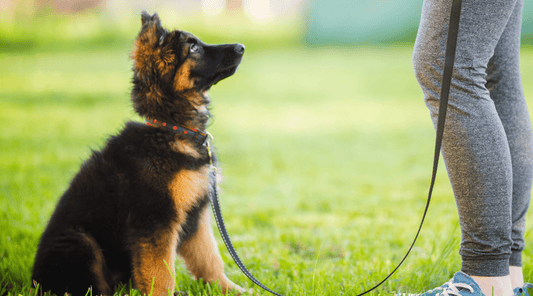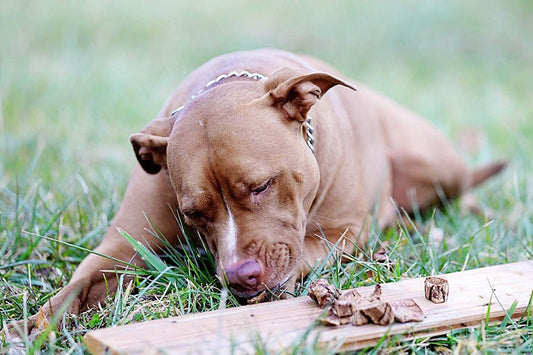Is Beef Trachea Safe for Dogs? Chewing on The Facts
Dawn Miller Jul 10, 20245 Minute ReadThe other morning, I was helping my next-door neighbor trim some unruly rose bushes that had taken over her front porch. She'd captured more than one door-to-door salesperson on her doorbell camera getting caught unaware by those prickly branches. So, it was time to do something about it.
It reminded me of roses' dual nature. As beautiful as they are, every rose has its thorns.
Roses aren't the only things having an identity crisis. Not all dog bones and treats are safe.
So today, I wanted to answer your question: How safe is dried beef trachea for dogs?
What Are Beef Trachea Dog Chews?
A beef trachea is the windpipe of a cow. It's made up of flexible cartilage covered in ligaments, the tracheal muscle and fibrous connective tissue.
As in all mammals, these soft tissues are loaded with bone- and joint-supportive glucosamine and chondroitin. They also have collagen, the most common protein in a mammal's body.
While the trachea is technically not a dog bone, it has many of the same benefits as all-natural marrow-filled dog bones. You can learn more about beef trachea chews on my FAQ page.
What Are the Benefits of Beef Trachea for Dogs?
The beef trachea is loaded with nutrition that dogs need to stay healthy—notably collagen, glucosamine, and chondroitin. But the benefits don't stop there. These dog chews also feed your dog's natural instinct to chew on things. It's good for their oral health. They can alleviate boredom and help support a sense of well-being.
Lastly, they make great training treats.
Beef trachea treats also have an added benefit that dog bones don't. They can be safer for senior dogs who may have more sensitive teeth and gums.
Now, don't get me wrong here. Dog bones aren't necessarily dangerous for teeth. It all depends on the kind of dog bone—beef bones are best. And how it's prepared to achieve the perfect density matters. It shouldn't be too hard or too soft.
With that context, I'll mention that if you're especially worried about your dog's teeth because they're older or have a history of tooth loss, a beef trachea tube could give your pup extra protection against tooth damage.
Now, onto the big question...
Is Beef Trachea Safe for Dogs?
According to the American Kennel Club (AKC), trachea is soft enough not to reduce the chances of tooth damage but durable enough that it doesn't easily break apart to form a choking hazard.
Generally, beef trachea is very safe for dogs of all sizes. However, the safety of beef trachea for dogs depends on how it's prepared and your dog's chewing habits.
If they are raw or improperly dried, the trachea can harbor harmful pathogens. In that regard, it is no different from raw meat. If my dog is going to be running around my house and licking my kid's faces, I don't want them eating raw meat.
It's very easy to remedy this with a slow and low-heat cooking and drying process. It locks in the flavor but kills off the worrisome bacteria.
These tasty treats are not recommended for very aggressive chewers because they won't last long. It would be better to buy long-lasting dynamo bones if this describes your dog. Beef trachea can also present a choking hazard.
Free Marrow Refill Recipe Guide
How Safe Are Beef Trachea Treats for Dogs?
It's softer than a dog bone, so small pieces can break off. These can get lodged in the throat.
That said, dog choking is a rare occurrence.
But as a rule of thumb, I always give my dogs bones and treats when I can stay close to them. Usually, I'm doing a little gardening or making dinner with my dogs less than 10 feet away from me.
Even though dog choking is very rare, a choking incident is not the time to learn the Heimlich maneuver, so since we're on this topic, I wanted to share how to recognize a choking dog and what to do about it.
Dog Choking Signs
A choking dog may show these signs:
- Gasping
- Making exaggerated breathing noises
- Paws on the face
- Falling over and flailing
- Unconscious
Choking can include partial blockages or total. If there is a total blockage, you might not hear anything and will need to watch their actions or lack of movement.
What to Do for a Choking Dog
Here's what to do according to PetMD.
- Approach your dog quickly and calmly
- Carefully restrain your dog
- Open their mouth
- If you can see the object, pull their tongue forward
- Use a sweeping side motion to pull the food out.
- Be careful not to push it in further.
- If within reach, use a spoon to scoop an object just out of reach.
The above method is best for dogs that have fallen unconscious.
If you cannot physically remove the object, you can perform a dog Heimlich Maneuver.
- Stand or sit behind your dog, depending on its size
- Press their spine against your chest
- Wrap your arms around them, placing a fist under their ribs.
- Cup one fist inside the palm of the other hand
- Do 5 rapid thrusts into their abdomen and upward
- If it doesn't fly out, give them 5 thrusts between the shoulders
- See if the object has moved forward where you can reach it
- Repeat
If the dog is too big to lift, you should raise its hind legs, using gravity to force the object out. Then, squeeze its abdomen.
For a toy-size dog, lift them by their feet and swing them side to side—but not too hard.
And, of course, call your vet when you feel safe to do so.
Tips to Keep Beef Trachea Safe for Dogs
The benefits of a trachea tube outweigh the risks for most pet parents. But there are some general tips for safe and enjoyable trachea gnawing experiences.
- Don't give your dog bones or other treats without supervision.
- Dog chews and bones should be used as treats, not a significant portion of your dog's diet.
- Limit each treat time to 15–20 minutes 2-3 times a week
- Never give your dog a bone or chew that is small enough to swallow—unless you buy beef lung dog treats that are intended to be chewed and swallowed
- If a piece of a bone, toy, or chew breaks off, distract your furry friend so you can take the choking hazard away.
- Replace your dog's chews on a regular schedule.
- Never feed your dog raw beef trachea.
- Look for a company with a slow and low-heat cooking process to retain flavor but kill bacteria that can make you and your family sick.
- As a bonus, choose grass-fed beef treats because they contain more vitamins A, D, and E, plus Omega 3.
- Opt for trachea from cattle raised in the USA to both support our American cattle ranchers and because it's easier to know where the animal parts came from.
- If you have an aggressive chewer, you might choose mammoth marrow bones instead. They'll last longer!
Where I Get Beef Trachea Safe for Dogs
The best beef trachea undergoes a slow and low-heat hickory smoking process to lock in flavor and produce beef trachea safe for dogs. Here's where I find USA-raised grass-fed beef trachea.
Available On:
Disclosure: This article may contain affiliate links, which means we may earn a small commission if you make a purchase through these links—at no extra cost to you. We only recommend products we trust and believe will benefit you and your K9.






